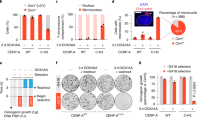Summary
Short-term lymphocyte cultures from three unrelated patients showed an increased frequency of mitoses with separated centromeres and splayed chromatids in the presence of colcemid. We refer to this phenomenon as premature centromere division (PCD). In two of the three patients the frequency of PCD in lymphocytes decreased when colcemid was omitted prior to harvest but was still higher than controls, whereas in the third patient, the frequency appeared unchanged. Cultured fibroblasts from the latter patient exhibited increased tetraploidy and multinucleated cells. Transmission of the trait in the three families was compatible with autosomal dominant inheritance. Time lapse cinemicrographic studies on fibroblasts from one patient demonstrate a shortened metaphase time, suggesting that the separation of chromatids observed in this patient may indeed be premature. The nature of the mutation(s) and phenotypic correlation if any is unknown.
Similar content being viewed by others
References
Chamla Y, Bequeret J (1982) Colchicine resistance in human cell lines. Pleiotropic phenotype and decreased membrane permeability. Hum Genet 61:73–75
Chamla Y, Roumy M, Lassegues M, Battin J (1980) Altered sensitivity to colchicine and PHA in human cultured cells. Hum Genet 53:249–253
Fitzgerald PH, McEwan CM (1977) Total aneuploidy and age-related sex chromosome aneuploidy in cultured lymphocytes of normal men and women. Hum Genet 39:329–337
Fitzgerald PH, Pickering AF, Mercer MJ, Miethke PM (1975) Premature centromere division: A mechanism of non-disjunction causing X chromosome aneuploidy in somatic cells of man. Ann Hum Genet 38:417–428
Freeman MVR, Williams DW, Schimke RN, Temtamy SA, Vachier E, German J (1974) The Roberts syndrome. Birth Defects X:87–95
Galloway SM, Buckton KE (1978) Aneuploidy and aging: chromosome studies on a random sample of the population using G-banding. Cytogenet Cell Genet 20:78–95
German J (1979) Roberts syndrome. 1. Cytological evidence for a disturbance in chromatid pairing. Clin Genet 16:441–447
Judge C (1973) a sibship with the pseudothalidomide syndrome and an association with Rh incompatibility. Med J Aust 2:280–281
Mazia D (1961) Mitosis and the physiology of cell division. In: Brachet J, Mirsky AE (eds) The cell. Academic Press, New York, pp 77–412
Michels VV, Medrano C, Venne VL, Riccardi VM (1982) Chromosome translocations in couples with multiple spontaneous abortions. Am J Hum Genet 34:507–513
Rose GG (1954) A separable and multipurpose tissue culture chamber. Tex Rep Biol Med 12:1074–1983
Seabright M (1971) A rapid banding technique for human chromosomes. Lancet II:971–972
Sisken JE (1964) Methods for measuring the length of the mitotic cycle and the timing of DNA synthesis for mammalian cells in culture. In: Prescott D (ed) Methods in cell physiology. Academic Press, New York, pp 387–401
Sisken JE (1973) The effects of p-dl-fluorophenylalanine on chromosome movement and cytokinesis of human amnion cells in culture. Chromosoma 44:91–98
Sisken JE, Bonner SV, Grasch SD (1982) The prolongation of mitotic stages in SV40-transformed versus non-transformed human fibroblast cells. J Cell Physiol 113:219–223
Sumner AT (1972) A simple technique for demonstrating centromeric heterochromatin. Exp Cell Res 75:304–306
Tomkins DJ, Hunter A, Roberts M (1979) Cytogenetic findings in Roberts-SC phocomelia syndrome. Am J Med Genet 4:17–26
Author information
Authors and Affiliations
Rights and permissions
About this article
Cite this article
Rudd, N.L., Teshima, I.E., Martin, R.H. et al. A dominantly inherited cytogenetic anomaly: A possible cell division mutant. Hum Genet 65, 117–121 (1983). https://doi.org/10.1007/BF00286646
Received:
Issue Date:
DOI: https://doi.org/10.1007/BF00286646




